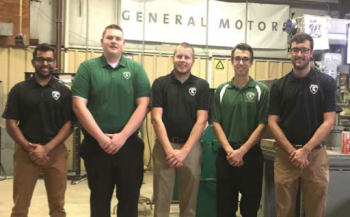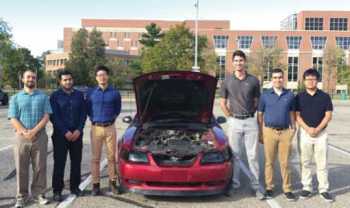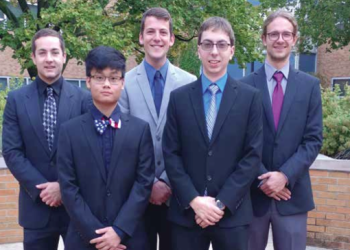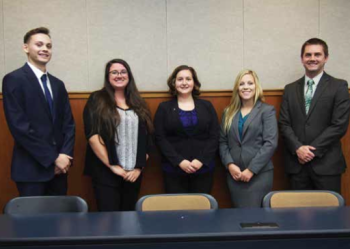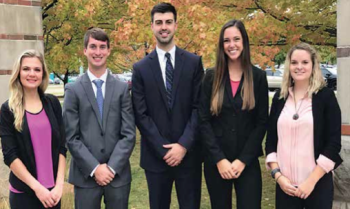Mechanical Engineering
Projects
One goal of the MSU Mechanical Engineering Program is to educate engineers who are prepared to lead, create, and innovate as their professional or graduate careers evolve. The Mechanical Engineering Design Program is the key element of the curriculum that supports this goal. There are five required design courses in the program which provide our students with eight hands-on, team-based, ‘design, test and build’ projects, and numerous opportunities to practice and refine their written, oral, poster, and video presentation skills. The Design Program in Mechanical Engineering has attracted national recognition on many occasions and helps to distinguish the ME program as one of the best in the country.
For information on becoming a project sponsor, please contact Mike Colucci.
The following were the project sponsors and projects for Fall 2017:
AP Lazer: Carriage Table Design Optimization
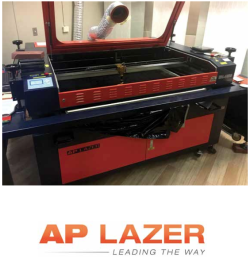 AP Lazer is a leader in laser etched engraving and has been providing both equipment and engraving solutions for customers for many years. With a patented product, AP Lazer uses CO2 coupled with the most powerful yet compact laser system on the market. With both heavy-duty and portable products, AP Lazer has the ability to engrave almost anything regardless of weight or size. AP Lazer has the ability to etch endless ranges of material including leather, stone, wood, and many metals. Although many applications involve etching of flat surfaces, AP Lazer has the ability to etch across any product regardless of orientation. This allows the etching of round objects such as mugs or balls, or etching of surfaces on an angle. You name the product; AP Lazer can do the rest.
AP Lazer is a leader in laser etched engraving and has been providing both equipment and engraving solutions for customers for many years. With a patented product, AP Lazer uses CO2 coupled with the most powerful yet compact laser system on the market. With both heavy-duty and portable products, AP Lazer has the ability to engrave almost anything regardless of weight or size. AP Lazer has the ability to etch endless ranges of material including leather, stone, wood, and many metals. Although many applications involve etching of flat surfaces, AP Lazer has the ability to etch across any product regardless of orientation. This allows the etching of round objects such as mugs or balls, or etching of surfaces on an angle. You name the product; AP Lazer can do the rest.
Our team worked in collaboration with AP Lazer to update and enhance their current laser carriage across all product sizes. Updates consisted of the addition of an alignment system to assist and facilitate the process of centering the base beneath the laser. In addition to the alignment process, cosmetic enhancements such as the addition of a flexible computer mount, toolbox, and form of which the table is leveled were evaluated against potential alternatives. These updates and additions added to the efficiency and appeal of AP Lazer’s product.
General Motors: Baja SAE CVT Dynamometer
 Baja SAE is a collegiate design series where teams design, manufacture, and race off-road vehicles. These teams compete each year in SAE organized events across the country. Competitions are four-day long events requiring the team to balance cost, marketing, innovative design, and performance throughout a series of static and dynamic events. One of the major components of the powertrain on Baja SAE vehicles is the Continuously Variable Transmission (CVT), which uses a combination of flyweights, movable sheaves, and a belt to achieve an infinite number of gear ratios. Obtaining the proper ratio at the correct time is crucial for vehicle performance.
Baja SAE is a collegiate design series where teams design, manufacture, and race off-road vehicles. These teams compete each year in SAE organized events across the country. Competitions are four-day long events requiring the team to balance cost, marketing, innovative design, and performance throughout a series of static and dynamic events. One of the major components of the powertrain on Baja SAE vehicles is the Continuously Variable Transmission (CVT), which uses a combination of flyweights, movable sheaves, and a belt to achieve an infinite number of gear ratios. Obtaining the proper ratio at the correct time is crucial for vehicle performance.
Previously, Michigan State Baja has used a Continuously Variable Transmission designed for snowmobiles but, more recently, has made the move to using a Gaged CVT on their car. With the increased tuning capabilities offered by a Gaged CVT, the team manufactured and programed a dynamometer in order to find the optimal tuning parameters for the CVT. The design team also created a math model to predict how the CVT will behave under different loading conditions in order to cut down the amount of time and different tuning conditions required for optimization. After the math model and dyno testing were completed, the design team ran vehicle testing in order to validate the results obtained from the dyno. The Michigan State Baja SAE team hopes to use the results in order to better tune its CVT and to be able to design a fully customized CVT in the future.
DENSO North America Foundation: Design of a Portable Ignition Test Bench
 Denso is one of the largest global automotive suppliers of advanced technology, systems, and components. In the automotive field, an ignition system is an important component that contributes to engine efficiency, pollutant reduction, and robustness. Spark ignition engines are being operated at increasingly high compression ratios and at boosted and lean conditions, which require the ignition system to have higher arcing voltage and ignition energy.
Denso is one of the largest global automotive suppliers of advanced technology, systems, and components. In the automotive field, an ignition system is an important component that contributes to engine efficiency, pollutant reduction, and robustness. Spark ignition engines are being operated at increasingly high compression ratios and at boosted and lean conditions, which require the ignition system to have higher arcing voltage and ignition energy.
Our team designed and built an ignition and flow test bench that will house ignition testing equipment and a removable ignition testing chamber. The design of the test bench requires it to be compact, portable and capable of measuring ignition energy in the ignition test chamber, while providing a flow of an inert gas from a cylinder to the ignition test chamber at a measured/controlled flow rate and supply pressure.
DENSO North America Foundation: Pressure Chamber to Measure Ignition Energy
 The DENSO North America Foundation, founded in 2001, is a corporate foundation dedicated to helping students advance their education in engineering and technology.
The DENSO North America Foundation, founded in 2001, is a corporate foundation dedicated to helping students advance their education in engineering and technology.
The ignition system in automotive applications is an important component that contributes to engine efficiency, pollutant reduction, and overall robustness of the vehicle. With advancements in technology, spark ignition engines (a type of internal combustion engine) are being operated at increasingly high compression ratios and at boosted and lean conditions, which require the system to have a higher arcing voltage and ignition energy. As a result of the changing operating conditions, there is a need to design and manufacture a low pressure chamber to explore the dependence of ignition energy on a range of conditions.
Our team designed and manufactured a chamber able to withstand pressures up to 5 bar and temperatures up to 200°C, which has the ability to be filled with a variety of inert gases and accommodate flowing or stagnant conditions. In addition, the chamber design entails an externally adjustable electrode gap for ease of testing and is compatible with the ignition test bench. Using the manufactured design, our team was able to demonstrate that ignition energy could be measured for various pressures, temperatures, electrode gap widths, flow, and ambient inert gas conditions relevant to internal combustion engines.

Team Members (L-R): Manea Yousuf Alhammadi, Jeri Ann Sutter, Alexander Athens, Jason Moll, Marissa Meaney, Paul Ferraiuolo
Ingersoll Rand – Trane: Ganged Door Handle Redesign
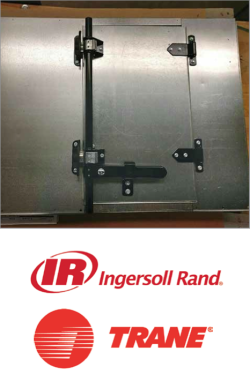 Our team has redesigned a door handle for Trane’s Air Handler Units. These units hold various components such as fans, coils, filters, electrical boxes, etc. This door handle assures proper latching for compression of the gasket seal to eliminate any potential air leakage into or out of the unit. The mechanism uses custom designed cams to push the strike plate, which is critical to the functionality of the door seal. The number of cams depends on the length of the doors, meaning our handle can be used on both large and small Air Handler Units.
Our team has redesigned a door handle for Trane’s Air Handler Units. These units hold various components such as fans, coils, filters, electrical boxes, etc. This door handle assures proper latching for compression of the gasket seal to eliminate any potential air leakage into or out of the unit. The mechanism uses custom designed cams to push the strike plate, which is critical to the functionality of the door seal. The number of cams depends on the length of the doors, meaning our handle can be used on both large and small Air Handler Units.
Trane’s original design allowed for adjustability, but this required very precise alignment of the cams to the rod. Tall doors required up to six cams to latch alignments and this resulted in long assembly times. The complexity of this design also added cost to the customer. After determining there was no need for this variability, our team designed a part that is fixed. This design allows for precise orientation of the latching mechanism during the assembly process. This door handle also has an easy latch system that can incorporate a padlock if needed, creating a door that will not shut and lock behind the user. This is also very ergonomic and safe for the user. This design is safer, higher quality, and more cost-effective because of the simplicity and reduced quantity of parts.
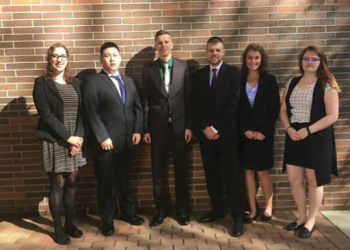
Team Members (L-R): Melissa Oudeh, Yurun Gu, Mark VanPoppelen, Andrew Hieber, Megan Friendrich, Laura Nye
Ranir: Semi-Automated Dental Floss Assembly
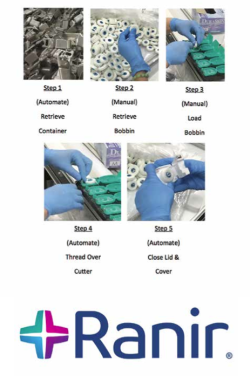 Ranir, located in Grand Rapids, Michigan, is a leading company in store brand dental care. Ranir produces a wide variety of dental products including toothbrushes, dental floss, flossers, specialty-powered toothbrushes, and many other innovative dental products. At the Grand Rapids location, one of the main products manufactured is dental floss. The current assembly process involves manual loading of the bobbins into the floss container then closure of the container. This manual process has numerous issues associated with it, including being labor intensive, having inconsistent production rates and having the potential for assemblers to develop injuries from the repetitive motion. Ranir desired an innovative solution to this problem.
Ranir, located in Grand Rapids, Michigan, is a leading company in store brand dental care. Ranir produces a wide variety of dental products including toothbrushes, dental floss, flossers, specialty-powered toothbrushes, and many other innovative dental products. At the Grand Rapids location, one of the main products manufactured is dental floss. The current assembly process involves manual loading of the bobbins into the floss container then closure of the container. This manual process has numerous issues associated with it, including being labor intensive, having inconsistent production rates and having the potential for assemblers to develop injuries from the repetitive motion. Ranir desired an innovative solution to this problem.
Our team was given the task of conceptually developing an automated solution to the dental floss assembly. The focus of the project was on the automation of the retrieval and closure of the floss container. The objective was to reduce the number of assemblers from three to one or two while increasing the production rates by 15 – 20%. Potential solutions to this problem were developed with the use of 3D models and prototypes while being analyzed to determine the optimal solution.
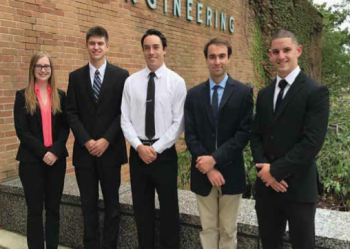
Team Members (L-R): Angela Dobrzelewski, Luke Boutler, Patrick Sharpe, Hunter Gvozdich, Darren Harnden
Kautex Textron: Replacing Validation Testing of Fuel Tanks with CAE
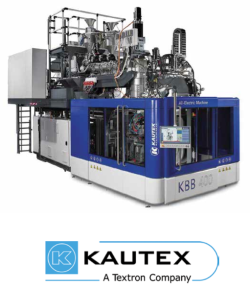 Kautex, a subsidiary of Textron, is one of the largest automotive suppliers in the world with facilities in 14 countries around the world. Kautex specializes in various systems such as blow-molded fuel systems and has used blow mold machines since 1949. The company strives to constantly improve their modern fuel systems while simultaneously reducing their environmental impact. Kautex does this through the use of High Density Polyethylene Extrusions, regrind, and ethylene vinyl alcohol to reduce atmospheric emissions. Kautex works with its various customers to constantly meet and exceed OEM specifications while striving to keep up with future technological trends.
Kautex, a subsidiary of Textron, is one of the largest automotive suppliers in the world with facilities in 14 countries around the world. Kautex specializes in various systems such as blow-molded fuel systems and has used blow mold machines since 1949. The company strives to constantly improve their modern fuel systems while simultaneously reducing their environmental impact. Kautex does this through the use of High Density Polyethylene Extrusions, regrind, and ethylene vinyl alcohol to reduce atmospheric emissions. Kautex works with its various customers to constantly meet and exceed OEM specifications while striving to keep up with future technological trends.
Our team was tasked with proving the possible validity of using CAE results to eliminate the timely physical design validation testing process based on a confidence factor. The benefits this project provides to the company include reduced testing costs, in addition to reducing the time necessary to perform lengthy tests. Because testing can often take weeks or months to perform, the ability to remove the design validation trials and tests (4-8 weeks and ~26 weeks, respectively), the benefits for Kautex are obvious. In addition to testing costs and time spent, this project provides the company with reduced fixture costs depending on the conclusiveness the tests express. The test that was run to accomplish this goal was the pressure vacuum test on the fuel tank with certain applications applying to various other tests. Further tests that the team performed included the pendulum hitting test, vibration test, and drop test.

Team Members (L-R): Tristan Eggenberger, Zexi Peng, Lingfeng Wang, Daniel Middleton, Muhammad Djafri, Taojun Wanyan
Consumers Energy: Gas Regulation Noise Reduction
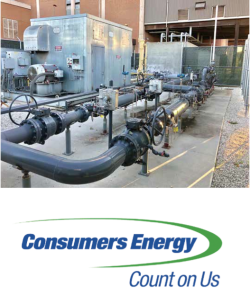 Consumers Energy provides electric and gas services to nearly seven million Michiganders, including Michigan State University community members. Consumers Energy supplies the natural gas for the T.B. Simon Power Plant that produces power for the majority of the buildings on Michigan State University’s campus. When natural gas comes from Consumers Energy distribution pipelines, inlet pressures surpass 200 PSI. The Simon Power Plant requires the delivery pressures to be 35 PSI, which requires the use of gas regulators to drop the pressure to this satisfactory level. Dropping the pressure is crucial for the function of the power plant; however, this significant reduction in pressure generates high noise pollution within the pipelines. The noise level readings near the four gas regulators exceed 95 dBA, equivalent to a Boeing 737 at one nautical mile. High noise levels produce safety concerns for employees who perform maintenance on and around the equipment.
Consumers Energy provides electric and gas services to nearly seven million Michiganders, including Michigan State University community members. Consumers Energy supplies the natural gas for the T.B. Simon Power Plant that produces power for the majority of the buildings on Michigan State University’s campus. When natural gas comes from Consumers Energy distribution pipelines, inlet pressures surpass 200 PSI. The Simon Power Plant requires the delivery pressures to be 35 PSI, which requires the use of gas regulators to drop the pressure to this satisfactory level. Dropping the pressure is crucial for the function of the power plant; however, this significant reduction in pressure generates high noise pollution within the pipelines. The noise level readings near the four gas regulators exceed 95 dBA, equivalent to a Boeing 737 at one nautical mile. High noise levels produce safety concerns for employees who perform maintenance on and around the equipment.
Consumers Energy requested our team to design a solution to reduce the noise level readings to be at a maximum of 85 dBA. The reduction in noise level would ensure that the Michigan Occupation Safety and Health Administration (MI-OSHA) threshold is achieved. With the reduction in noise, employees are not required to wear hearing protection, and the surrounding student housing benefits from the diminished sound pollution.
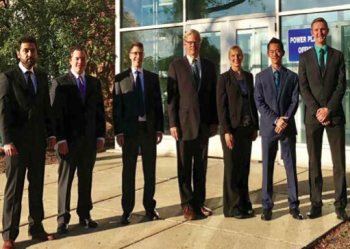
Team Members (L-R): Roobin Arbab, Zachary Engen, Tom Kobak, Indrek Wichman (Faculty Advisor), Jessica Montagano (Sponsor), Ihn Uyeb Hur, Jacob Flight
Peckham Inc.: Mechanical Coupling for Autonomous Train
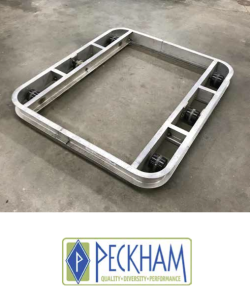 Peckham Incorporated, founded in 1976, is a nonprofit organization whose headquarters are located in Lansing, Michigan. Amongst other responsibilities, this location manufactures a variety of military clothing from raw materials to finished garments. This requires the constant, manual movement of materials and fabrics throughout the facility using bins placed on dollies (pictured to the right). To increase efficiency, Peckham Inc. is transitioning to an autonomous system that allows multiple bins to be simultaneously moved throughout the plant rather than manually moving one dolly at a time, which is their current process. This system allows for a maximum of three dollies to be connected to an autonomously driven “locomotive,” which is programed to drive on a given route. Peckham Inc. requested the development of a mechanical coupling so that dollies can be easily manually attached to and detached from one another along with the “locomotive.” The facility includes a large quantity of dollies, so it was important that the mechanical coupling was a low-cost device, while still being able to handle the stresses of the system. Additionally, the team was asked to take into consideration the potential needs of the operators at any given time, so a quick and simple attach-and-release system was desired. The goal of this project was to provide a prototype, together with the design of an inexpensive, easily manufactured device so that Peckham Inc. would be able to either manufacture or contract a company to produce the devices as needed.
Peckham Incorporated, founded in 1976, is a nonprofit organization whose headquarters are located in Lansing, Michigan. Amongst other responsibilities, this location manufactures a variety of military clothing from raw materials to finished garments. This requires the constant, manual movement of materials and fabrics throughout the facility using bins placed on dollies (pictured to the right). To increase efficiency, Peckham Inc. is transitioning to an autonomous system that allows multiple bins to be simultaneously moved throughout the plant rather than manually moving one dolly at a time, which is their current process. This system allows for a maximum of three dollies to be connected to an autonomously driven “locomotive,” which is programed to drive on a given route. Peckham Inc. requested the development of a mechanical coupling so that dollies can be easily manually attached to and detached from one another along with the “locomotive.” The facility includes a large quantity of dollies, so it was important that the mechanical coupling was a low-cost device, while still being able to handle the stresses of the system. Additionally, the team was asked to take into consideration the potential needs of the operators at any given time, so a quick and simple attach-and-release system was desired. The goal of this project was to provide a prototype, together with the design of an inexpensive, easily manufactured device so that Peckham Inc. would be able to either manufacture or contract a company to produce the devices as needed.
Meijer: Automated Swapping of Bottle Collection Bins
 In Michigan, Meijer is required by law to collect and recycle empty bottles sold in their stores and refund the customer a 10¢ deposit per bottle. To do this, Meijer currently has multiple semi-autonomous machines at each store that can collect the empty bottles, provide customers with their refund, and drop the bottles into a collection bin underneath the machine. The machine can detect when the bin reaches its full capacity and will stop accepting bottle returns until an empty bin is swapped into the machine.
In Michigan, Meijer is required by law to collect and recycle empty bottles sold in their stores and refund the customer a 10¢ deposit per bottle. To do this, Meijer currently has multiple semi-autonomous machines at each store that can collect the empty bottles, provide customers with their refund, and drop the bottles into a collection bin underneath the machine. The machine can detect when the bin reaches its full capacity and will stop accepting bottle returns until an empty bin is swapped into the machine.
Currently, the swapping of full bins for empty bins is a manual operation that requires workers to use a hand fork truck to move the bins around. The flaw with swapping the bins manually is that they fill up at different times during the day so workers have to periodically check the machines, and they aren’t always there when a machine’s bin fills up. This leads to periods of time where multiple machines are down with full bins, decreasing the number of machines in service and affecting customer satisfaction.
Meijer asked our team to create an automated system that can swap the full bins with empty bins and place the full bins in the staging area before they are shipped to the recycling center. The goals of the automated system were to reduce the need for workers to swap out the bins, reduce down-time on the machines when a bin is full, make the system versatile allowing it to be integrated into existing backrooms at all current Meijer locations, and incorporate safety features for workers around the machines.
Ingersoll Rand – Trane: Fan Isolation and Attenuation Device
 Ingersoll Rand manufactures a wide variety of industrial machines and systems used both commercially and privately. Trane, a subsidiary of Ingersoll Rand, specializes in air conditioning units including airflow devices such as fan arrays. The quality of airflow is paramount in these systems, as turbulent flow can increase energy use and noise production levels. Trane is interested in improving upon its fan arrays through redesigning inlet geometry, aiming to reduce noise production and ensure proper isolation of failed devices. Trane currently uses gravity-assisted backdraft dampers in their fan arrays, however they believe that better solutions exist.
Ingersoll Rand manufactures a wide variety of industrial machines and systems used both commercially and privately. Trane, a subsidiary of Ingersoll Rand, specializes in air conditioning units including airflow devices such as fan arrays. The quality of airflow is paramount in these systems, as turbulent flow can increase energy use and noise production levels. Trane is interested in improving upon its fan arrays through redesigning inlet geometry, aiming to reduce noise production and ensure proper isolation of failed devices. Trane currently uses gravity-assisted backdraft dampers in their fan arrays, however they believe that better solutions exist.
Our team was tasked with simulating new inlet configurations with the use of CFD software to analyze airflow velocities, deviations and flow profiles. Utilizing Ansys and its CFX solver, various geometries were tested to find solutions that offer lowest average outlet velocity, as well as low velocity deviation in that flow field. An ideal solution also closes the inlet in the event of fan failure, preventing backdraft and unwanted noise. The final design is intended to fit various square geometry fan arrays, sizing anywhere from 14” – 36” square.
Ingersoll Rand – Trane: Optimized Diffusion of AHU Fan Discharge
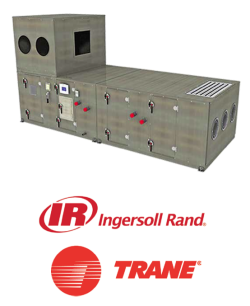 Trane, a subsidiary of Ingersoll Rand, is one of the leaders in the manufacturing of Air Handling Units (AHUs). In buildings, the air handling units are responsible for moving air throughout the entire building. In addition to moving the air, the AHUs can humidify, filter, heat, or cool airflow. For the most effective performance of these devices, the air velocity is adjusted to match the requirements of the building. Air moves through the AHUs by one of two means, either a plenum fan or a housed fan. A housed fan can push air to velocities up to 3,000 ft/min directly downstream of the fan’s discharge, exceeding the acceptable air velocity through some downstream components and building regulations.
Trane, a subsidiary of Ingersoll Rand, is one of the leaders in the manufacturing of Air Handling Units (AHUs). In buildings, the air handling units are responsible for moving air throughout the entire building. In addition to moving the air, the AHUs can humidify, filter, heat, or cool airflow. For the most effective performance of these devices, the air velocity is adjusted to match the requirements of the building. Air moves through the AHUs by one of two means, either a plenum fan or a housed fan. A housed fan can push air to velocities up to 3,000 ft/min directly downstream of the fan’s discharge, exceeding the acceptable air velocity through some downstream components and building regulations.
Our team designed a diffusor to aid in the reduction of the air velocity out of the fan. The larger the distance between the fan and diffuser, the more material required to create the AHU and the more space it takes up. This increases the cost of the product and, thus, must be minimized. The objective was to design and test a diffuser to slow down air from a housed fan to an average face velocity of 500 ft/min while reducing the length around the current diffuser by 20%. This solution was to be implemented in as many AHU sizes and geometries as possible.
Tenneco Automotive Operating Company Inc.: Diesel Exhaust Fluid Heater and Reactor
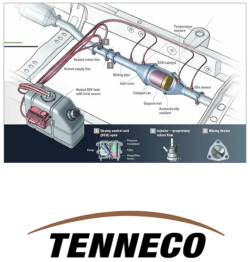 Tenneco Automotive Operating Company Inc. is a global manufacturing company pioneering global ideas for cleaner air and smoother, quieter, and safer transportation. Tenneco is one of the world’s leading designers, manufacturers, and distributors of Clean Air and Ride Performance products and technology solutions for diversified markets, including light vehicle, commercial truck, off-highway equipment, and the aftermarket. Emissions of NOx from internal combustion engines contribute to the high concentration of atmospheric ozone in the modern world and are associated with health hazards. Selective Catalytic Reduction (SCR) is a leading method for reducing NOx emissions that Tenneco is dedicated to continue developing.
Tenneco Automotive Operating Company Inc. is a global manufacturing company pioneering global ideas for cleaner air and smoother, quieter, and safer transportation. Tenneco is one of the world’s leading designers, manufacturers, and distributors of Clean Air and Ride Performance products and technology solutions for diversified markets, including light vehicle, commercial truck, off-highway equipment, and the aftermarket. Emissions of NOx from internal combustion engines contribute to the high concentration of atmospheric ozone in the modern world and are associated with health hazards. Selective Catalytic Reduction (SCR) is a leading method for reducing NOx emissions that Tenneco is dedicated to continue developing.
As part of that mission, our team has been tasked with using a numerical computing environment to develop a model, designing a prototype utilizing CAE software, and manufacturing a prototype reactor for the heating and reaction of Diesel Exhaust Fluid (DEF), an aqueous urea solution, to generate an ammonia-rich gas mixture. Complying with guidelines provided by Tenneco, the final prototype designed by our team provided an engineering model and prototype solution that could facilitate new product development for companies in the automotive emission control industry.
Siemens Corporation: Cryogenic Pipe Thermo-Mechanical Support
 Siemens AG is a German conglomerate company headquartered in Berlin and Munich. It is the largest industrial manufacturing company in Europe with branch offices abroad.
Siemens AG is a German conglomerate company headquartered in Berlin and Munich. It is the largest industrial manufacturing company in Europe with branch offices abroad.
Cryogenic pipe thermo-mechanical support will provide a significant advantage in existing markets, and enable Siemens to enter new markets with industry- leading technology. Conventional cooling methods utilize air or water; replacing this with a cryogenic cooler will result in higher cooling capacity. This will lead to more compact designs, which could result in cost savings exceeding twenty percent.
Our team focused on building a structure to support the center pipe within the confines of the exterior pipe. The center pipe carries a cryogenic fluid, which reaches temperatures as low as 30 K. This structure could only transfer a limited amount of heat into the cold center pipe from the 318 K exterior pipe. The support must also be able to endure thermal cycling and loads in excess of one million Nm-1. The team did rigorous analysis on multiple support designs, considering both the thermal and mechanical restrictions. A physical prototype for visual reference was produced after the Siemens representative decided upon a suitable option.
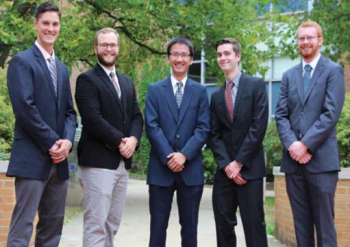
Team Members (L-R): Jonathan Andrejczuk, Nicholas Raterman, Hai Nguyen, Michael Okuniewicz, Brendan Webberly
Michigan AgrAbility: Design of a Muck Bucket Dolly
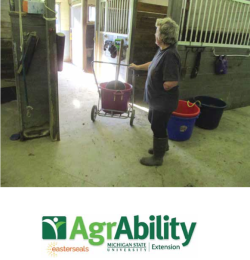 Michigan AgrAbility is a joint partnership between Michigan State University (MSU) Extension and Easter Seals of Michigan, which assists workers in the agricultural industry with completing tasks that are difficult as a result of age, disability or illness. Providing this service allows workers to continue in their occupation.
Michigan AgrAbility is a joint partnership between Michigan State University (MSU) Extension and Easter Seals of Michigan, which assists workers in the agricultural industry with completing tasks that are difficult as a result of age, disability or illness. Providing this service allows workers to continue in their occupation.
Many tasks around a farm involve moving and lifting heavy buckets. Specifically, horse farms require cleaning of stalls, which entails moving and lifting a bucket that can weigh as much as 60 pounds. Workers with certain physical conditions (such as back, arm or leg injuries) can find the task of moving and lifting a muck bucket to be difficult and may risk additional injuries.
In order to help solve this problem, the MSU team designed a dolly that can secure the bucket with minimal effort, transport it through rough terrain, and then lift the bucket a minimum of 45 inches where it would be high enough to slide onto a trailer or other vehicle. The design was evaluated by a potential user and a prototype built with the goal of being a device that can be produced by farmers across the state, as needed.
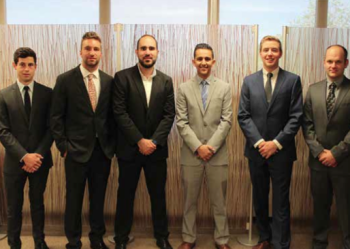
Team Members (L-R): Kevin McCarty, Mitchell Pollee, Anxhelo Lalaj, Amad Wahib, Michael Rasmussen, Matthew Walz
Hitachi Automotive Systems Americas, Inc.: Test Stand for Variable Valve Timing
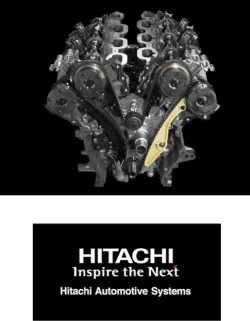 Hitachi is a global company that designs and manufactures products for the government, consumers and businesses. Some of the industries in which they create products are health care, security, digital media, industrial infrastructure, mining, logistics and automotive. One of the largest sectors of their business is in Automotive Systems. In Farmington Hills, Michigan, there is a project team at Hitachi that tests Variable Valve Timing Systems (VVT), otherwise known as Variable Camshaft Timing (VCT). These systems consist of gears and chains that are located on the front of a vehicle’s engine and connect to the engine’s camshaft. Hitachi performs tests on these systems by simulating how an engine will operate after production. This is done by running a customer supplied prototype engine with VVT systems in a controlled environment. Recently, the customer decided they are not going to be providing Hitachi prototype engines to test their VVTs due to the high cost.
Hitachi is a global company that designs and manufactures products for the government, consumers and businesses. Some of the industries in which they create products are health care, security, digital media, industrial infrastructure, mining, logistics and automotive. One of the largest sectors of their business is in Automotive Systems. In Farmington Hills, Michigan, there is a project team at Hitachi that tests Variable Valve Timing Systems (VVT), otherwise known as Variable Camshaft Timing (VCT). These systems consist of gears and chains that are located on the front of a vehicle’s engine and connect to the engine’s camshaft. Hitachi performs tests on these systems by simulating how an engine will operate after production. This is done by running a customer supplied prototype engine with VVT systems in a controlled environment. Recently, the customer decided they are not going to be providing Hitachi prototype engines to test their VVTs due to the high cost.
Our team had the task of designing a test rig that mimics the bottom section of an engine block and attaches to the cylinder head, which will still be provided by the customer. The final system design is a NX 11.0 CAD model. This test rig is adaptable to multiple engine types from V8 through inline 4 with minimal modifications. The system provides oil lubrication mimicking a production engine. This will provide Hitachi with a more cost-effective solution for testing their VVTs.
Fraunhofer USA: Fixture for a Thin Film Application to Spheres
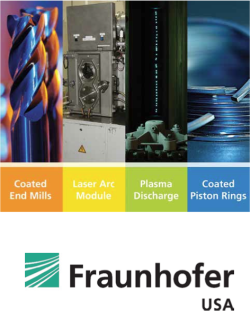 Fraunhofer USA is a professional research partner that develops innovative solutions utilizing thin film coatings and diamond materials. Fraunhofer specializes in applications involving chemical and physical vapor deposition (CVD/PVD) to coat various geometries. Methods such as PVD utilize a Laser-Arc Module (LAM) that creates a modular plasma source, which is used to create a tetrahedral amorphous carbon (ta-C) thin film coating. This coating is extremely hard and has a low coefficient of friction, making it ideal for high wear applications. However, one of its limitations includes a line-of-sight application characteristic, requiring complex fixtures in order to achieve an even coating thickness of ta-C.
Fraunhofer USA is a professional research partner that develops innovative solutions utilizing thin film coatings and diamond materials. Fraunhofer specializes in applications involving chemical and physical vapor deposition (CVD/PVD) to coat various geometries. Methods such as PVD utilize a Laser-Arc Module (LAM) that creates a modular plasma source, which is used to create a tetrahedral amorphous carbon (ta-C) thin film coating. This coating is extremely hard and has a low coefficient of friction, making it ideal for high wear applications. However, one of its limitations includes a line-of-sight application characteristic, requiring complex fixtures in order to achieve an even coating thickness of ta-C.
Currently, fixtures for the LAM can only coat certain geometries, not including spherical objects. The challenge presented to the Michigan State University team was to design, build and test a fixture that allows for spherical objects, such as ball bearings, to be coated with ta-C. To accomplish this, the fixture must allow for electrical conductivity between the work pieces and fixture to attract ionized ta-C. Additionally, the fixture must function within a chamber that experiences a high vacuum and temperature for each thin film application cycle. Design considerations for the final design included the ability to scale the design to maximize the amount of ball bearings to be coated, manufacturability of the fixture, and the ease of cleaning the ball bearings and fixture pre- and post-coating, respectively.
James Dyson Foundation: Inclusive Sports Wheelchair
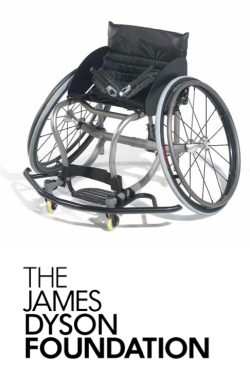 The MSU Adaptive Sports Club provides opportunities for people with a diverse range of disabilities to participate in a wide array of sports. In order to accommodate the needs of its athletes, the club possesses a variety of equipment. However, one piece of equipment that it lacks is a sports wheelchair that can be used by athletes who are affected by upper body muscle asymmetry and also possess relatively complete lower body functionality. Two members of the club have these characteristics, and they have been unable to participate in many of the sports that the club plays. The club came to the team seeking a specialized wheelchair that would allow these athletes to fully and safely participate in the club’s activities.
The MSU Adaptive Sports Club provides opportunities for people with a diverse range of disabilities to participate in a wide array of sports. In order to accommodate the needs of its athletes, the club possesses a variety of equipment. However, one piece of equipment that it lacks is a sports wheelchair that can be used by athletes who are affected by upper body muscle asymmetry and also possess relatively complete lower body functionality. Two members of the club have these characteristics, and they have been unable to participate in many of the sports that the club plays. The club came to the team seeking a specialized wheelchair that would allow these athletes to fully and safely participate in the club’s activities.
The team started with a standard sports wheelchair and integrated a device that allows the chair to be powered by the athlete’s legs rather than by his or her arms. This device does not compromise the integrity of the wheelchair frame and allows the user to steer and brake easily despite his or her input limitations. The design was optimized for safety, cost, strength, and serviceability using iterative design techniques. The prototype has been tested and approved by the two athletes of interest and their input has been essential in refining the final design. This addition to the club’s collection of equipment will enable it to better serve its members by allowing broader participation in its activities.
Marathon Petroleum Corporation: Tee Ball Batter Assist Device
 Marathon Petroleum Corporation (MPC) is a prime sponsor of the Miracle Field baseball complex in Findlay, Ohio. The facility and leagues that play there provide an opportunity for children with disabilities to participate in organized baseball. The facility lacks a device to allow children who can’t swing a bat to participate. The development of a batter assist device for tee ball-level players would provide an opportunity for a much wider audience to participate in the Miracle League program. Several current MPC employees have children that are, or will be, part of the program and could benefit from the batter assist device. The impact of this project would go well beyond MPC and would be a benefit to other families in Findlay and surrounding communities.
Marathon Petroleum Corporation (MPC) is a prime sponsor of the Miracle Field baseball complex in Findlay, Ohio. The facility and leagues that play there provide an opportunity for children with disabilities to participate in organized baseball. The facility lacks a device to allow children who can’t swing a bat to participate. The development of a batter assist device for tee ball-level players would provide an opportunity for a much wider audience to participate in the Miracle League program. Several current MPC employees have children that are, or will be, part of the program and could benefit from the batter assist device. The impact of this project would go well beyond MPC and would be a benefit to other families in Findlay and surrounding communities.
The MSU Team worked with MPC employees and Miracle Field board members to design a device that assists tee ball-level children with disabilities. The device allows a child who is not able to hold or swing a bat to safely hit the ball from a tee. The device must be portable (easy to move into position and out of the way to accommodate batters in a game situation), durable, and activated with very simple means (e.g, push button). Ideally, the device would provide some degree of control over the trajectory of the ball to give the batter some strategic options.
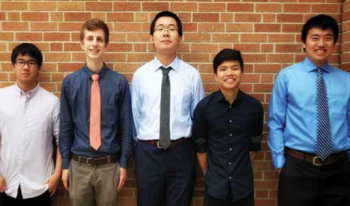
Team Members (L-R): Shiyuan Zhong, Michael VanBemmelen, Nan Chi, Nor Shanfiq Mohdnoor, Syunsuke Hata
Heartwood School: Adaptive Sports Ball Launcher
 Heartwood School employs the MOVE Curriculum designed to improve the mobility and strength of children with a range of disabilities, both physical and mental. The MOVE Curriculum allows students to participate in sports activities with nondisabled peers. With an adaptive sports ball launcher, students with limited ranges of mobility are able to engage in sports such as basketball and volleyball. Heartwood School students range in age from two and a half to 26 so the ability of the sport ball launcher to adapt to different heights and disabilities was a main component of all design choices. It is an entirely enclosed and safe device because safety is Heartwood’s number one priority.
Heartwood School employs the MOVE Curriculum designed to improve the mobility and strength of children with a range of disabilities, both physical and mental. The MOVE Curriculum allows students to participate in sports activities with nondisabled peers. With an adaptive sports ball launcher, students with limited ranges of mobility are able to engage in sports such as basketball and volleyball. Heartwood School students range in age from two and a half to 26 so the ability of the sport ball launcher to adapt to different heights and disabilities was a main component of all design choices. It is an entirely enclosed and safe device because safety is Heartwood’s number one priority.
By touching an assistive switch, students are able to send a signal to the launcher to effectively launch a ball. The adaptive sports ball launcher can launch a children’s sized basketball or a regulation sized volleyball from the free throw line or 3-point line. To ensure the launcher would work for the wide range of students at Heartwood, the launcher was designed with easy angle and speed adjustments. Using a two-wheel system, with each wheel rotating in opposite directions, the launcher is able to be adjusted for many distances and speeds. A large battery was used to power the system in order to both remove the risk that extension cords can pose around children and increase the overall portability of the system. This sports ball launcher will aid in improvement of mobility for all students at Heartwood.
Bosch: Welding Apparatus for Turbo Waste Gate Lever
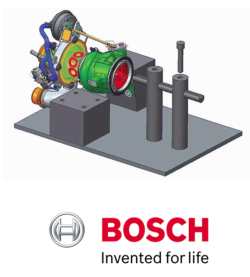 For this project, our team was tasked with creating an automated welding apparatus capable of welding the waste gate on a Bosch turbo. Previously, a fixture existed to hold the turbo in place, but the apparatus was needed to control the path of the welding tool, the speed of the tool, and the power to the tool.
For this project, our team was tasked with creating an automated welding apparatus capable of welding the waste gate on a Bosch turbo. Previously, a fixture existed to hold the turbo in place, but the apparatus was needed to control the path of the welding tool, the speed of the tool, and the power to the tool.
Bosch ordered a 3D gantry system that controls the position of a plate as well as the speed. Our team was responsible for creating a fixture to mount the welding tool onto the plate of the gantry system, allowing the path to be controlled. Next, the gantry system was mounted on the existing turbo weld fixture. Finally, the gantry system was programmed with Microsoft Excel to move the welding tool in the correct path.
The most important aspect of this weld is the repeatability. This weld must be the same for each prototype part that is used in this fixture to ensure the appropriate turbo performance. This means that the path of the weld tool must be the same every time. Because of this requirement, it is very important that the welding tool is completely locked into position and firmly connected to the gantry system.
This weld will provide Bosch value by decreasing lead-time on prototype turbos for customers. Previously, prototypes had to be sent to a Bosch location in Germany to be manufactured because the plant in North America is much smaller. The North America branch is now able to process orders more quickly and become more independent.
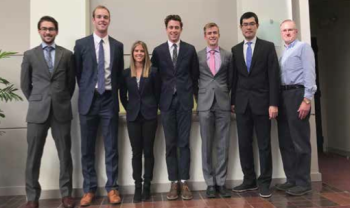
Team Members (L-R): Jacob Smyth, Mitchell Holt, Carly Wolf, Nicholas Wojno, Trey Pfeiffer, Ruichen Li, Alfred Loos (Faculty Advisor)

